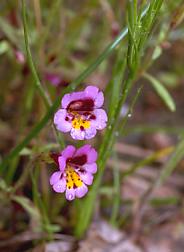
Diplacus angustatus is a species of monkeyflower known by the common names purplelip pansy monkeyflower and narrowleaf pansy monkeyflower.

Diplacus bigelovii is a species of monkeyflower known by the common name Bigelow's monkeyflower. It is native to the southwestern United States, where it grows in desert and slope habitats. It was formerly known as Mimulus bigelovii.

Diplacus brevipes is a species of monkeyflower known by the common name widethroat yellow monkeyflower. It was formerly known as Mimulus brevipes.
Erythranthe breweri is a species of monkeyflower known by the common name Brewer's monkeyflower. It is native to western North America from British Columbia to California to Colorado, where it grows in moist spots in several habitat types. This is a hairy annual herb producing a thin, erect stem up to 21 centimeters tall. The herbage is reddish green in color. The paired opposite leaves are linear in shape and up to 3.5 centimeters long. The plant bears small tubular flowers, each with its base encapsulated in a lightly hairy calyx of sepals with tiny equal lobes at its mouth. The five-lobed flower corolla is just a few millimeters long and light purplish pink in color, often with darker spots in the throat. It was formerly known as Mimulus breweri.
Diplacus clevelandii is an uncommon species of monkeyflower known by the common name Cleveland's bush monkeyflower. It was formerly known as Mimulus clevelandii.
Diplacus congdonii is a species of monkeyflower known by the common name Congdon's monkeyflower.

Diplacus cusickii is a species of monkeyflower known by the common name Cusick's monkeyflower. It is native to the western United States, where it can be found in parts of the Pacific Northwest and Great Basin. It grows in moist spots in bare and scrubby habitat, rocky slopes and plateau.

Erythranthe filicaulis, known by the common name slender-stemmed monkeyflower, is a species of monkeyflower. It was formerly known as Mimulus filicaulis.

Erythranthe floribunda is a species of monkeyflower known by the common name many-flowered monkeyflower. It is native to western North America from western Canada to California and northern Mexico, to the Rocky Mountains. It grows in many types of habitat, especially moist areas. It was formerly known as Mimulus floribundus.

Diplacus fremontii is a species of monkeyflower known by the common name Frémont's monkeyflower. It is native to California and Baja California, where it grows in mountain and desert habitat, especially moist or disturbed areas. It was formerly known as Mimulus fremontii.

Diplacus mohavensis is a species of monkeyflower known by the common name Mojave monkeyflower.

Diplacus nanus is a species of monkeyflower known by the common name dwarf purple monkeyflower. It is native to California and the Northwestern United States to Montana. It grows in moist habitat, often in bare or disturbed soils. It was formerly known as Mimulus nanus.

Diplacus pictus is a species of monkeyflower known by the common name calico monkeyflower.
Diplacus pulchellus is an uncommon species of monkeyflower known by the common name yellowlip pansy monkeyflower. It was formerly known as Mimulus pulchellus.

Diplacus pygmaeus is a species of monkeyflower known by the common name Egg Lake monkeyflower.
Diplacus rattanii is a species of monkeyflower known by the common name Rattan's monkeyflower.

Diplacus torreyi is a species of monkeyflower known by the common name Torrey's monkeyflower.

Diplacus tricolor is a species of monkeyflower known by the common name tricolor monkeyflower. It is native to Oregon and California. It grows in seasonally wet habitats such as meadows and vernal pools, including those in the San Joaquin Valley and near north coast oak woodlands. It was formerly known as Mimulus tricolor.
Diplacus viscidus is a species of monkeyflower known by the common name sticky monkeyflower.
Diplacus whitneyi is a species of monkeyflower known by the common name Harlequin monkeyflower. It was formerly known as Mimulus lewisii.












